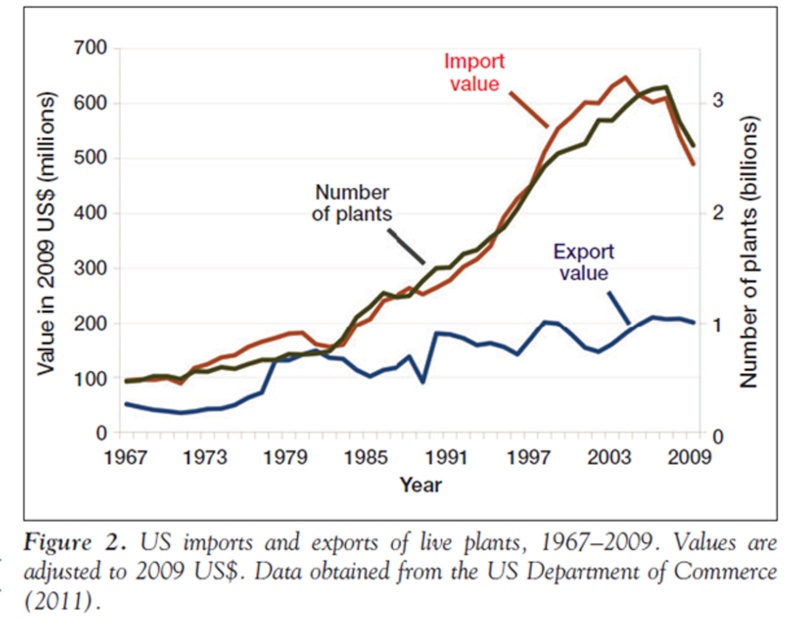 Theme: The risk of spreading Phytophthora ramorum via live plant imports
Theme: The risk of spreading Phytophthora ramorum via live plant importsFaith Campbell, The Nature Conservancy, Arlington, Virginia
Plant imports carry a high risk for pest movement. The approach rate (the number of organisms arriving at a border) is 12% for the plants for planting pathway (Liebhold et al. 2012), one hundred times greater than that for wood packaging (Haack and Rabaglia 2013).
The figure above shows that plant import volumes into the USA increased four-fold between 1967 and 2007. These rising import volumes result in increased pest introduction risk. While the number of plants imported through the USDA’s Miami Port Inspection Station increased by almost 100% between FY1995 and FY2002, the number of quarantine pests found in those shipments increased by 275% (USDA APHIS 2004). Fortunately, imports of lower-risk cuttings have increased faster than imports of whole plants; imports of cuttings increased 242% between 1996 and 2005, while overall plant imports during that period increased only 28% (Liebhold et al. 2012).
Approximately 90 new plant pests were detected in the US from 2009 – 2012. Hosts of these pests range from onions and grasses to sweet potatoes to oak trees. Based on an analysis of APHIS’ database in 2012, at least 37 of these pests belong to pest types often associated with a living material pathway, e.g., imports of plants, cuttings, foliage, or cut flowers. The plant-associated pests included:
• 6 viruses
• 16 fungi, rusts, and downy mildews
• 5 whiteflies
• 5 aphids or scales
• 5 mites.
Pathways of pest introduction are often difficult to determine. Of recently introduced tree-killing pathogens, two are vectored by insects transported primarily by movement of wood, e.g., crates and pallets, firewood, or wood for woodworking (laurel wilt and thousand cankers of walnut). A third, the Fusarium carried by the polyphagous shot hole borer, might have entered the country on either wood or imported plant material. A fourth, Texas Phoenix Palm Decline (TPPD) phytoplasma, is also vectored by an insect, so it might have been introduced either on imported plant material or via transport of the vector (Elliott and Harrison 2007.)
Currently, trade data are collated in ways not particularly helpful to predicting or understanding the likelihood of future pest introductions. Available data do show which regions receive the largest numbers of rhododendrons and azaleas per year; they are, in descending order, Michigan and Ohio (combined 471,000); New York and New Jersey (combined 369,000); Maryland and Virginia (combined 274,000); Oregon (247,500), and California (232,500) (Colunga et al. 2013). The ecological similarities between the source and recipient locations of imported plants, an important factor in determining the likelihood that any pest associated with the shipment will be able to establish, has also been documented (Colunga et al. 2013). However, a pest’s introduction does not always occur at the place with the highest volumes of imports. For example, Hawai`i ranks 44th in imports of foliage and branches; yet it still received o’hi`a rust. There is an element of luck involved; if even a few shipments infested with a pathogen arrive at a site with suitable hosts and conditions, the pathogen could establish.
For Discussion: Given the likelihood that imports of plants and cuttings are likely to continue in large volumes, and from increasingly varied origins, what actions can regulators, businesses, and concerned individuals take to minimize the risk of pests being introduced to new areas?
Literature CitedColunga-Garcia M.; Haack, R.A.; Magarey, R.D.; Borchert, D.M. 2013. Understanding trade pathways to target biosecurity surveillance. In: Kriticos, D.J.; Venette, R.C. (Eds). Advancing risk assessment models to address climate change, economics and uncertainty. NeoBiota. 18: 103–118.
Elliott, M.L. and Harrison, N.A. 2007. Palm diseases caused by phytoplasmas: Lethal yellowing and Texas Phoenix Palm Decline. University of Florida. IFAS. Fort Lauderdale Research and Education Center.
Haack, R.A. and Rabaglia, R.J. 2013. Exotic bark and ambrosia beetles (Coleoptera: Curculionidae: Scolytinae) in the United States: Potential and current invaders. In, Potential invasive pests of agricultural crop species, Peña, J.E. ed.; Wallingford, UK: CAB International. Chapter 3.
Liebhold, AM.; Brockerhoff, E.G.; Garrett, L.J.; Parke, J.L.; Britton, K.O. 2012. Live plant imports: The major pathway for forest insect and pathogen invasions of the United States. Frontiers in Ecology and the Environment. 10: 135–143.
United States Department of Agriculture Animal and Plant Health Inspection Service. 2004. Federal Register Proposed Rules. Vol. 69, No. 237. December 10, 2004. Nursery stock regulations.
